| « Battle: Los Angeles, Red Riding Hood, happythankyoumoreplease, Mars Needs Moms & Of Gods and Men | Art All Over the Place » |
Feature Fri Mar 11 2011
Pulaski Daze: Walking Pulaski Road
This article was submitted by freelance writer John Greenfield.
When I was choosing the next roadway to tackle as part of my project to walk the lengths of all of Chicago's major thoroughfares, Pulaski Road sprang to mind as one the city's iconic streets. So far I'd hiked Milwaukee, Western, Halsted, Archer, Grand, 63rd, Kedzie, Belmont, 79th, King and Lawrence, discovering a wealth of tasty eats, historic sights and friendly folks.
Named after Casimir S. Pulaski, the Polish-American hero of the Revolutionary War known as "the father of the American Calvary," Pulaski Road stretches 21.7 miles across this city, said to have more Poles than any town but Warsaw. But the street was originally named Crawford Avenue after early Chicago pioneer Peter Crawford, and the name change created a controversy that lasted almost two decades.
In 1933 Mayor Ed Kelly, wishing to gain favor with the city's largest ethnic voting block, agreed to a request from a Polish group to honor their countryman, and the City Council approved the change. But Crawford's descendants objected, and businesses along Crawford didn't want to have to change their addresses on signage and advertising. Legal battles continued for years, Pulaski Road signs were frequently stolen, and a streetcar conductor who announced a stop as Crawford was punched out by a Polish passenger. After much back and forth, the Illinois Supreme Court decided the case for once and for all in 1952 and the name Pulaski has stuck ever since.
After deciding to observe my own private Pulaski Day, I wake up early on a bitter cold Wednesday morning in early January and catch a couple of CTA buses from Logan Square to 115th and Springfield, a block east of Pulaski. My friend Kristen Ostberg, a fellow freelancer who writes the Bridgeport blog the Hardscrabbler, is joining me for the walk and we're meeting for breakfast at George's Diner, 11750 S. Pulaski in suburban Alsip. As I head south on Springfield into Alsip there are small houses but no sidewalk — it feels like I'm in a small town.
Kristin's waiting for me at the diner, a small Wild West-style building, and there's a free amuse-bouche of mini doughnuts sitting on the table. It's just after New Year's and the place is still packed with tinsel and Santa cutouts, plus numerous baskets of multicolored silk flowers. On the way to the restroom there's a shelf filled with ceramic and soft sculpture chickens; a sign above it featuring three hens says, "STUFFED WITH GRATITUDE."
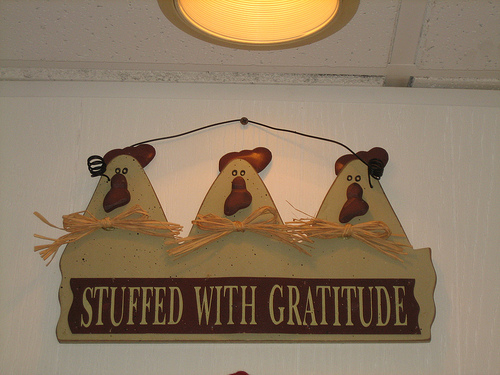
Stuffed with my Caribbean omelet (tomato, mozzarella, avocado and fake crab) I begin my march north with Kristen. At 116th we see looks like an abandoned drive-in with cool old signs for "char-co burgers" and root beer. An Internet search shows this is the Frosty Mug Drive In, which was once featured on the Food Network's "Diners, Drive-Ins and Dives," but the main sign is missing. Hopefully it's just closed for the season.
So far, Pulaski is a busy four-lane. At 115th we enter the city's Mount Greenwood neighborhood and come to the Chicago Agricultural High School, located on 72 acres where the city's last traditional farm once stood. The school teaches agricultural skills to city kids and includes a functioning farm and golf course. We walk across the frozen, furrowed fields and visit a livestock pen next to the school building with horses, sheep, cattle and goats.
At 111th, Ranch Manor shopping center flies the U.S., Illinois and Irish flags, and there's a sign for Quigley's Irish Pub featuring a fiddle and a pint of Guinness. North of here there are modest homes with sloping, lopsided saltbox roofs, and soon we start seeing banners for St. Xavier University.
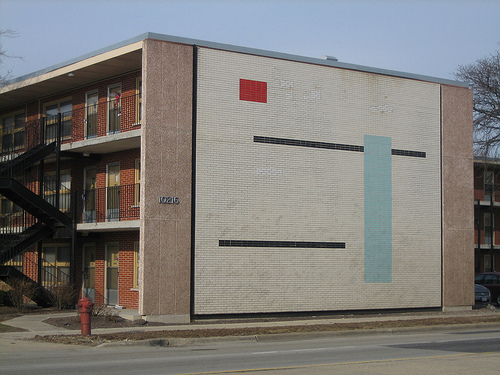
A postwar apartment building at 10216 South features a huge, Piet Modrian-inspired abstract design in terra cotta brick on its side. At 99th we temporarily leave the city — we'll be walking past Evergreen Park, Oak Lawn and Hometown for 1.5 miles.
We're surprised to see Wojo's, 9851 South, a fast food joint advertising "bison dogs from Wrigley Field," turkey, ostrich and elk burgers. Ken Wojcicki, who's owned the place for 30 years, tells us he started serving exotic proteins during the Atkins craze. "These meats are lower in fat and cholesterol than beef or chicken," he says. "Bodybuilders love the ostrich — it's all protein." He asks if we know why Wrigley Field serves bison dogs. "This is not a joke," he says. "It's because Mr. Rickets owns a buffalo farm."
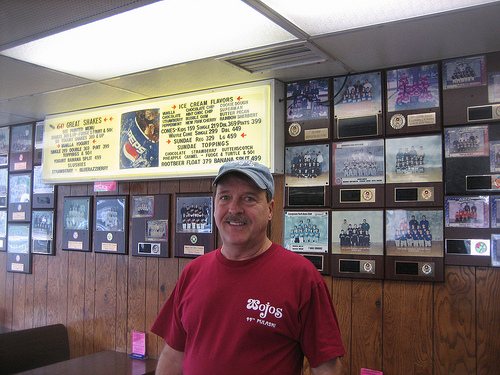
We pass the Shibui condo complex, 9720 South, which has Japanese-looking wooden pavilions, then come to Trinity Evangelical Covenant Church at 93rd, which looks a bit like an Alpine lodge. After walking by St. Mary's Catholic Cemetery at 91st, we arrive at the Hometown Veterans Memorial, a small circular plaza with artillery guns ringed with flag. A box of TNT Pop-Its noisemakers lies on the ground nearby.
Crossing 87th back into the city we come to Rosario's Sausage, 8611 South, in business since the '50s. The shop is notorious for its neon sign, featuring pigs happily jumping into a meat grinder and coming out the other side as encased meat links, spelling out the word "sausage." The store also sells a nice selection of Italian groceries, plus Chicago-made Tom Tom Tamales. I laugh at the vintage cartoon on the tamale wrappers, with a little girl begging a boy, "Oh, give me a bite."

At 81st Pulaski is bigger than ever, with four travel lanes and continuous turn lanes. A fire station at 78th has its flags at half-mast in honor of Edward Stringer and Corey Ankum, two firefighters who recently died battling a blaze in a South Shore warehouse when the roof collapsed. At 76th we come to the bleak campus of Richard J. Daley College, which seems difficult to access unless you park your car on the south side of the street and take a skyway to the classroom buildings on the north side.
At 74th we pass by an Army Reserve center with trailers parked outside, ominously labeled "Hazmat Recon." The road rises to clear some railroad tracks and a young man on a BMX bike speeds down the hill on the sidewalk towards us. The weather has grown gray and murky but we get a ghostly view of the Loop from the summit. To our left is the sinister-looking industrial complex of Grace Davidson, 4099 W. 71st, a chemical company with the slogan, "Enriching lives, everywhere."
Richard Tan, a foodie with a seemingly photographic memory who joined my on my Kedzie walk, sent me a long list of recommended eats along Pulaski. This included the torta ahogada, a "drowned sandwich" that's a specialty of Guadalajara, Mexico, and a popular snack at soccer stadiums. So when Kristen and I see them advertised at La Picosas, 6430 South, we stop for lunch. I get a jolt of happiness when the sandwiches arrive, shredded pork and pickled onions on a bolillo roll, drenched in devil-red chili de arbol sauce, delicious but so spicy I can barely finish mine.
 Afterwards we stop at Andy's Bowling Pro Shop. 6358 South, selling balls emblazoned with Chicago sports teams and Harley logos. A clear ball with a skull inside seems inspired by Jeanine Garofalo's superheroine the Bowler from the 1999 flick Mystery Men. An old man wearing a "Black Bowling Association" jacket is buying a ball for his grandson as a birthday present.
Afterwards we stop at Andy's Bowling Pro Shop. 6358 South, selling balls emblazoned with Chicago sports teams and Harley logos. A clear ball with a skull inside seems inspired by Jeanine Garofalo's superheroine the Bowler from the 1999 flick Mystery Men. An old man wearing a "Black Bowling Association" jacket is buying a ball for his grandson as a birthday present.
At 63rd the legendary Eyecare Indian greets us, and Pulaski is a six-lane road. We soon pass by a real estate office where a woman is hanging signs on the window for bungalows for sale as low as $30,000. "This is probably the foreclosure belt," says Kirsten. Sure enough, we soon encounter several more offices shilling cheap homes. At 55th, Mi Casa Real Estate has a big LCD sign reading, "Interest rates are at an all-time low. Don't pass up this opportunity."
El Portero Western Wear, 5312 South, sells alligator boots with fake eyes, making your foot look like the head of the gator. Boots made of stingray skin are for sale for $500. We're in the largely Mexican- and Polish-American West Elsdon neighborhood, and at Archer, 5100 South, we pass Marie Sklodowska Curie High, named for the Polish-French scientist who discovered the elements radium and polonium, named for her homeland.

Korona Lounge, 4710 South, has signs posted on the window, covering recently inflicted scratches and congratulating the vandal: "Certificate of Upgrade to Complete Asshole — just be yourself." When we sit down at the bar, a drunk old man leaves the gambling machine to yell at me for taking his seat, but the attractive Polish barmaid scolds him, pointing out he left his jacket on a different stool.
At the corner of the bar a bunch of blue-collar guys in flannel and baseball caps are discussing snowmobiling and a recent proposal to privatize the Taste of Chicago. I tell them about our project and ask Rich Szkarlat to characterize Pulaski Road for me. "It's an awesome north-south throughway," he says. "From 59th to 43rd, the last residential stretch, it's peaceful but once you get closer to 26th, watch out for the gangbangers."
As we continue, the ped-friendly retail is replaced with strip malls and big box stores after 43rd, and soon we're crossing the Stevenson and approaching red brick Crawford Station, a coal-fired power plant that environmental activists are trying to shut down. We walk several blocks past industrial areas and vacant lots until Pulaski becomes residential again at 31st with a series of modest brick "one-flats" that seem to have garden apartments below. We've entered largely-Mexican Little Village, and most of the businesses have signs in Spanish.
 It's getting dark, and we decide to stop walking for the day at the Pink Line, a few blocks north. First we walk a couple blocks west on 26th to check out businesses on Chicago's busiest neighborhood retail strip. We hit up Delicias Mexicanas, 4148 W. 26th, for a Acapulco-style hotdog con tocino ("with bacon"), wrapped in the smoked meat and topped with grilled onions, stewed and roasted jalapenos, mustard, mayo and — gasp! — ketchup. Very tasty.
It's getting dark, and we decide to stop walking for the day at the Pink Line, a few blocks north. First we walk a couple blocks west on 26th to check out businesses on Chicago's busiest neighborhood retail strip. We hit up Delicias Mexicanas, 4148 W. 26th, for a Acapulco-style hotdog con tocino ("with bacon"), wrapped in the smoked meat and topped with grilled onions, stewed and roasted jalapenos, mustard, mayo and — gasp! — ketchup. Very tasty.
Continuing north on Pulaski we cross under Metra tracks at 23rd, after which we're in Lawndale and the neighborhood changes abruptly from predominantly Mexican to African-American. The Goodie Shop, 2100 South, sells custom-printed t-shirts and other hip-hop gear. Owner Willie Porter, who runs the shop with his son Willie II, tells us the space used to be a bar called the Texas Lady, popular with transplants from the South. "When I first opened here it was really rough," he says. "Guys would be sitting in chairs in front of my store and challenge me, but I got to know them and now we get along fine."
The recently rehabbed Pulaski Pink Line station has futuristic stainless-steel canopies above the platform and mosaic-ed quote from Muhammad Ali downstairs: "The man who has no imagination has no wings."
Kristen and I meet back at the station the following Wednesday at 8am to resume our walk as flurries flutter in the air. At 1859 South we come to a series of brightly-colored murals by students from the city's After School Matters program showing families from the community with encouraging slogans like "Building Wisdom," "Love Your Neighborhood" and "An Hour a Day [of helping your child with her homework] Keeps the Streets Away."

We stop at the New Original Pine Valley Family Restaurant, 1600 South, a lunch counter with images of King, Obama and the Clintons on the walls, for cups of coffee and a slice of sweet potato pie. Grillman James Johnson, 61, tells us the restaurant has been here 57 years and has served musicians from funk bass pioneer Larry Graham to R. Kelly.
Johnson moved here from near Tupelo, Mississippi, in 1963, initially working as a paperboy. He lived down the street from King when the reverend moved into an apartment at 15th and Homan to call attention to conditions in northern slums. "He was like the new guy on the block," Johnson recalls. "Quiet and laid back."
Continuing, we come to an abandoned luncheonette at 1442 South with signs advertising catfish and raccoon. Really? The Chicago West Side Christian School, 1241 South, has a mosaic featuring Billy Holiday, Malcolm X, Harriet Tubman and Barack Obama, and images of youth dodging drugs and violence to get their diplomas and move towards careers.
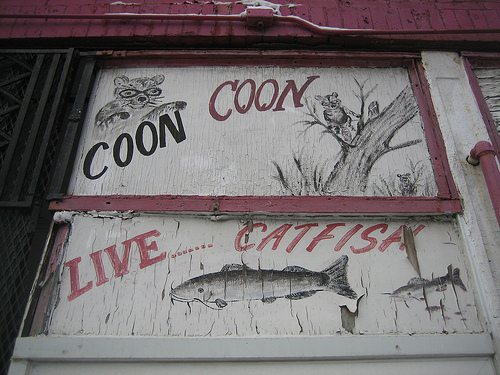
Richard Tan recommended Mary's Bar B Q, 606 South, whose motto is "Where the sauce is boss and every bone is well worth eating," as having the most atmosphere of any BBQ shack in town, but it's not open yet. We cross over the Ike and Blue Line into Garfield Park. The Mirador, a castle-like building at Jackson, is boarded up, and there's a cool old sign at a shuttered restaurant called "The Place to Eat," 140 South.
There's a bustling shopping district along Madison that's home to many stores selling hip hop fashions. When we stop to check out some colorful old row houses east of Pulaski on Ontario Street, a car pulls up and the driver is curious about what we're up to. He says he grew up around here and went to the army, then got into the construction business. He says his wife doesn't like him coming around to the old neighborhood. "It's gotten pretty bad here, but the young men know me," he says. "A lot of these kids, their mom is out drinking and smoking crack, but I was blessed — I had a father and a mother."
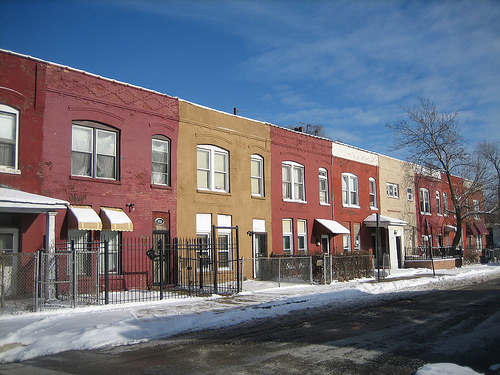
Orr High School, 800 North, has a big, colorful mural titled "Urban World at the Crossroads" on the side of the gym. The work features images of hands typing at a keyboard, playing chess, gardening and other performing other constructive activities.
We duck into the 939 Club, 939 North, intrigued by a sign that says, "No gym shoes, no Timberlands, no white Ts, no sagging pants." Inside there's a big, horseshoe-shaped bar, the walls are paneled with mirrors, and a photo of a man in a white, furry pimp outfit hangs above the bar. It's Dwayne "Doc" Anderson, the owners' son. He tells us the club has been open for 40 years and has hosted celebrities like Snoop Dogg, Crucial Conflict and Bishop Don "Magic" Juan, and that part of the film Dr. Detroit, was filmed here. "So you like walking Pulaski?" Anderson says, "After you cross Division Street you're going have to run."
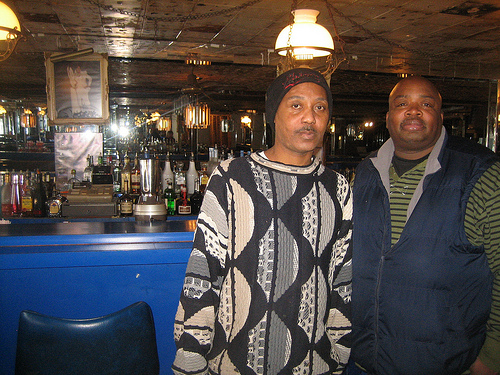
The neighborhood does change after a few blocks, and Spanish signs appear again. We stop into El Sitio, 1253 North, one of the city's few Dominican Republic-style restaurants. "We opened right after Sammy Sosa left town," says owner Peter Jimenez, holding his young daughter Ana. He says on weekends the place turns into a nightclub with merengue, bachata and reggaeton music. Paco Arez, the cook, offers us a sample of Bandera ("flag"), the national dish of stewed chicken with beans and rice. When I ask about a typical Dominican drink, Arez pours us shots of Brugal Rum.
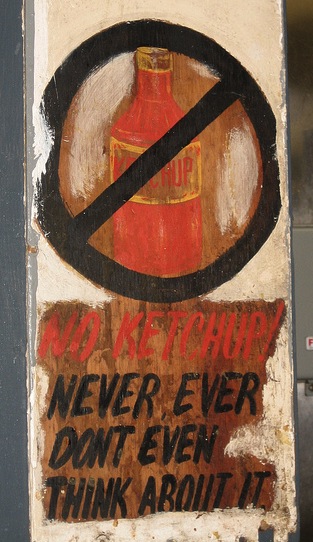 Continuing north we duck into Jimmy's Red Hots, 4000 W. Grand (1400 North), with an elegantly simple menu of red hots, Polish sausage, fries and Supreme tamales. An old sign on the wall shows a bottle of ketchup in a circle with a line through it reading, "No ketchup, never ever. Don't even think about it." I pick up one of the calorie-dense Chicago-made tamales to eat as we stroll.
Continuing north we duck into Jimmy's Red Hots, 4000 W. Grand (1400 North), with an elegantly simple menu of red hots, Polish sausage, fries and Supreme tamales. An old sign on the wall shows a bottle of ketchup in a circle with a line through it reading, "No ketchup, never ever. Don't even think about it." I pick up one of the calorie-dense Chicago-made tamales to eat as we stroll.
Mosaicos Jaliscos, 1513 N. Pulaski, sells the colorful decorative tiles you often see at Mexican restaurants. Photos of Zapatistas and mariachis hang on the walls. The old Pioneer Trust Savings Banks building, 4000 W. North, features bold bas-relief images of miners, construction crews and steel workers. There's a nice mural under the viaduct at 1800 North, including the image of a beautiful female guitarist.
North of Fullerton is a building supply district, including Green Depot, 2500 North, "Your source for environmentally friendly living and building. The mural outside of El Cubanito, 2555 North, features a young man staring at the ample backside of a lady who's eating one of the shop's signature Cuban sandwiches. "Mmm... Que rico!" ("How rich!") he says, licking his lips.
At Diversey we come to the former site of the Olson Waterfall and Park, at the northwest corner of the intersection. The owner of the Olson Rug Company opened the 22-acre green space next to his mill in 1935. With its 35-foot waterfall modeled after one in Michigan's Upper Peninsula, duck pond, flowers, teepees and statue of a Native chief, it was a picnic hotspot. But Marshall Field's bought the factory, and in 1978 they paved this paradise to put up a parking lot. Macy's now owns the building.
We stop to warm up at the Belford Tavern, 3200 North, the name an amalgamation of its former cross streets, Belmont and Crawford. Nowadays it's a liquor store and taproom, but the bartender, a Greek immigrant, brings out a yellowed menu from the 1940s, back when a steak was fifty cents. "That guy used to fight in the Greek resistance," jokes Ed Gale, a veteran of the Marines sitting to my right. An Anglo, he says used to run with Puerto Rican gangs when attended nearby Schurz High and got kicked out for fighting. "My old man said, 'If you ain't gonna go to school you're gonna go to work,'" Gale tells me. "I got sick of stirring mortar so I joined the service."

Continuing up Pulaski, we stop at La Humita, 3466 North, another Richard Tan-recommended eatery that serves Ecuadorian food in a slightly upscale setting, and we pick up the restaurant's eponymous specialty, yet another style of tamale, incorporating cheese and whole corn kernels. The sign outside is shaped like a giant ear of corn.
I want to give Kristen a quick look inside La Villa, 3638 North, an old-school Italian place with some of the best deep-dish pizza in town. When the extremely friendly Sicilian-born owner, Christina Petrancosta, hears what we're up to she insists on giving us a full tour of the place, including the giant kitchen where cooks are shaping ground beef into massive meatballs. Petrancosta invites us to come back on Friday for a free dinner with longtime customers to watch a new "Check Please" episode featuring the restaurant.

We're in the Old Irving Park community and we detour west on Grace Street, 3800 North, to check out some of the neighborhood's famous Victorian architecture. We pass under a Metra viaduct with a colorful mural of neighbors raking leaves, barbecuing and shoveling snow with the legend, "A country home within 15 minutes of the city."
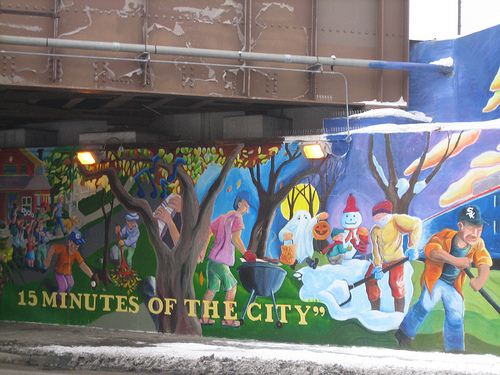
The intersection of Pulaski and Elston, 4300 North, is home to a number of North African businesses. We stop into Pomera, an Algerian bakery at 4304 North, to sample chabakia, a cookie that is fried in olive oil and dipped in honey and sesame seeds, traditionally served during Ramadan. Nearby Tassili, 4342 N. Elston, a restaurant named after a Saharan mountain range, is known for its tagines — slow-cooked Moroccan stews.
Tres Américas Books, 4336, is Mecca for Chicago's Latino intelligentsia, a cozy, Barbara's Bookstore-like space with hundreds of volumes of fiction and poetry in Spanish, plus all kinds of other books, from children's literature to cookbooks to manuals like Sexo: La Mejor Guía de los Amantes.
Kristen needs to finish some writing that evening, so she begs off and backtracks to the Blue Line. I continue north towards multiethnic Lawrence Avenue — I notice the first sign in Korean sign at 4539 North. I duck into El Jeeb Grocery, 4805 North, a small store with a good selection of Middle Eastern staples: rice, chickpeas, spices, nuts and pickles. The freezer holds bags of okra, green fava beans and Jew's mallow.
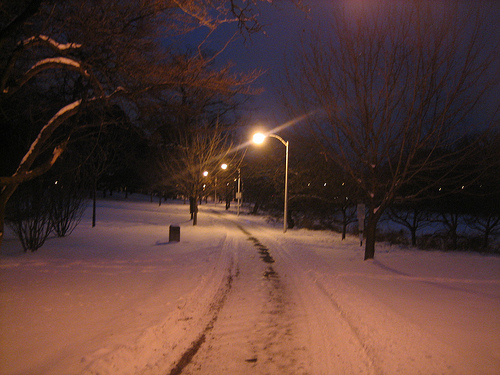
It's been dark for a while now and snow-covered Gompers Park, 5100 North, honoring American Federation of Labor founder Samuel Gompers, looks ghostly under lamplight. I cross the north branch of the Chicago River and head past the castle-like gateway of Bohemian National Cemetery, located between Bryn Mawr and Foster. The graveyard, founded by Czechs in 1877, holds many of the victims of the Eastland disaster as well as assassinated Chicago mayor Anton Cermak, who took a bullet for FDR in Miami in 1933.
In 2009 the cemetery added a monument for Cubs fans. It's a brick wall, a replica of the ivy-covered wall at Wrigley, with niches for 288 urns of funereal ashes, featuring a stained glass image of the scoreboard. Stadium seats and a bench from the team's bullpen are installed nearby. Says Dennis Mascari, who spearheaded the project, "I've helped give die-hard Cubs fans a way to forever support their team."
I trudge through four inches of snow past North Park Village Nature Center, 5801 North. Though it's only three blocks long, the 46-acre center seems much larger. Its hiking trail is a great place to escape the city as it climbs a man-made hill, circles a pond and provides views of the tame deer that live in the preserve.
St. Odisho Church of the East, 4201 North, flies the Assyrian flag, representing an ethnic group from Iran, Iraq, Syria and Turkey that traces its origins back to the early Fertile Crescent civilization. Across the street from the church is a small store which sells Assyrian-themed gifts, like ostrich eggs painted with the image of an ancient winged lion sculpture, reproductions of cuneiform tablets, statuettes and "Hug me I'm Assyrian" t-shirts.
After Devon, 6400 North, Pulaski becomes Crawford as it enters the suburb of Lincolnwood at the Bryn Mawr Country Club. Before heading home, exhausted but satisfied, I retreat to the Backyard Grill snack shop, 6355 North, to refuel with a pulled pork sandwich and thaw out my wet, frozen feet.

~*~
This feature is supported in part by a Community News Matters grant from The Chicago Community Trust and the John S. and James L. Knight Foundation. More information here.









Kelly Reaves / March 11, 2011 12:47 PM
Great job on this, John! Pulaski is one of my favorite streets in the city because it is a main artery of the REAL Chicago, IMO. You've really captured the spirit of the city here.